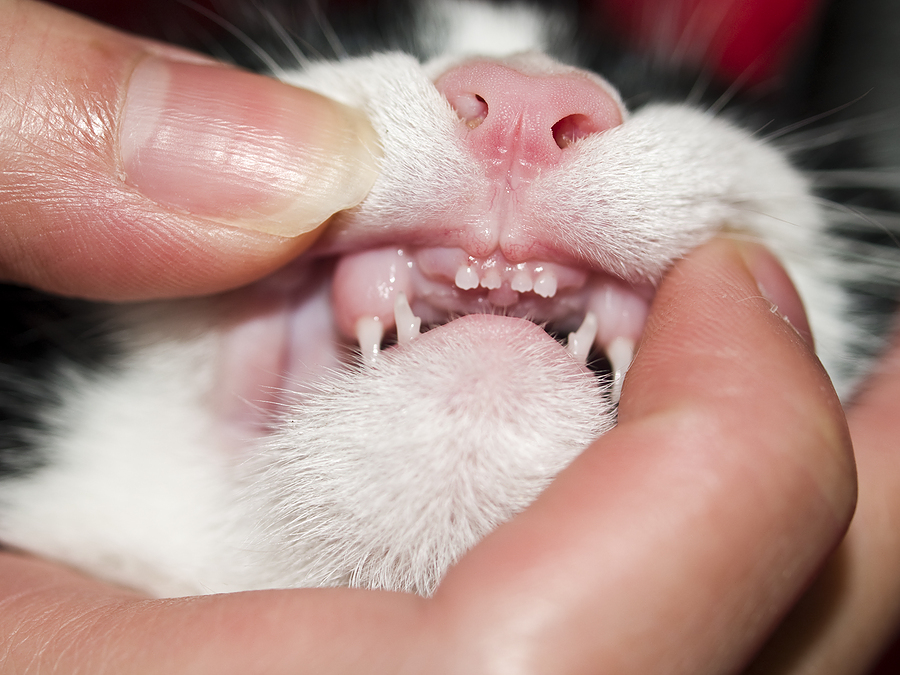When Animal Control picked up a little stray Poodle that I’d later adopt, she was a mess. Among a host of health issues, Peach was missing 18 teeth and needed another seven extractions. So we’re protective of her remaining teeth, which my husband and I affectionately call “chompers.”
But the other day, I gave her a little cookie, and she put it on her bed to save for later. Is she planning ahead, or was it too hard for her chompers to chew?
Is she experiencing dental pain?
Signs of Trouble
Picking up food and then dropping it can be a sign of dental pain in dogs and cats, says Sharon L. Campbell, DVM, MS, DACVIM, at Zoetis and a Fear Free certified veterinarian who serves on the advisory board.
“Signs of dental disease in general can start off with probably the most commonly recognized sign: halitosis, or bad breath,” she says. “We all have smelled that stinky dog breath and stinky cat breath.”
Unfortunately, dental disease can be painful. Dr. Campbell says other signs include drooling or pulling their head away when you try to pet it. Also look for yellow tartar, bleeding gums, and whenever a tooth is loose, broken, or discolored.
She emphasizes that if you notice your dog or cat has decreased appetite or weight change, it could be a sign of dental disease – or something critical.
“That’s an alarm,” she says. “When a pet owner notices that their dog or cat has decreased appetite and weight loss, let’s get them to the vet immediately because there’s something serious going on there.”
At the Root of Health Problems
Dr. Campbell notes dentists like to say that teeth are the window to the body because not only can dental disease cause pain locally, it can lead to gingivitis, which is irritation of the gums that can lead to loosening of the tooth and eventual tooth loss. A pet might get an infection in the root of the tooth that can cause fever or general disease.
“With an infection in the mouth, those bacteria can seep to other parts of the body and other vital organs,” she warns. “It can go to the liver, the kidneys, the heart in particular, and then you end up with conditions in those organs, too. So you’ve got a twofold effect: the local effect of all the irritation and pain and disease that can happen within the mouth itself, but then those bacteria that formed can shed to the rest of the body and cause disease elsewhere.”
Dental Care Best Practices
That’s why regular dental exams are so key to the overall health of our pets. During annual exams, veterinarians will always check the dog or cat’s mouth. Sometimes they’ll recommend a dental cleaning if they suspect disease or a need for extractions or require a closer look.
Anesthesia is an important part of an effective and thorough dental exam and cleaning. One reason is that the veterinarian will need to take x-rays of the teeth to see if there’s infection in the tooth roots – something pets don’t typically hold still for when they’re awake.
“A lot of the disease is below the gum line and they can’t see that and can’t get to it if the dog isn’t anesthetized,” she says.
Anesthesia also helps keep pets calm and allows veterinarians to get ahead of the pain when the veterinary team administers medications while the pet is under anesthesia. Scraping teeth can irritate the gums, causing pain – if a pet is awake, they’ll be stressed and painful.
“It’s very essential that the pets go under anesthesia for any type of dental procedure in order to have a thorough exam, a calm exam, a pain-free exam or procedure so that animals don’t remember what happened because they’re unconscious,” she says.
While pet owners can be wary of anesthesia, as evidenced by the rise of “anesthesia-free cleanings” in pet stores and other locales, Dr. Campbell says pet owners should be comforted knowing veterinarians use the same anesthetic medications used in human patients.
“They’re very safe, and they use dosages that are very safe,” she says.
Delay Decay
Of course, prevention is the best medicine. In addition to annual exams, Dr. Campbell recommends training a dog (or cat, though this can be more challenging) to tolerate home tooth brushing. Start with a regular soft toothbrush, or little rubber finger toothbrush, and cover it in peanut butter or squirt cheese. Let the dog lick it off to get used to the brush. Gradually get them used to the implement, and then start using toothpaste made for dogs and cats (typically flavored like chicken or liver).
“Try to make it a fun thing for them, so when you actually do go in there to brush their teeth, they’re not objecting to it,” she says.
Dr. Campbell also plays a game with her dog Huckleberry each evening: Find the Greenie. She hides the tooth chew in the house and the Australian shepherd mix runs around their home looking for it. His reward helps keep his teeth clean.
While some pet owners may think dental disease only affects older animals, studies have shown that dogs and cats as young as three years old already have some degree of disease. So it’s important to have conversations with your veterinarian about your pet’s dental health on a regular basis.
“We want to make sure those teeth stay bright and shiny, and that there’s no pain or irritation or bacteria build up in those teeth,” she concludes.
This article was reviewed/edited by board-certified veterinary behaviorist Dr. Kenneth Martin and/or veterinary technician specialist in behavior Debbie Martin, LVT.








